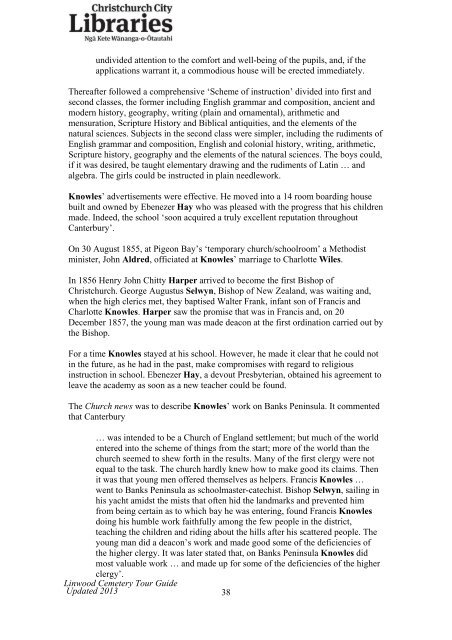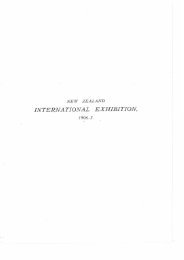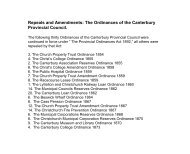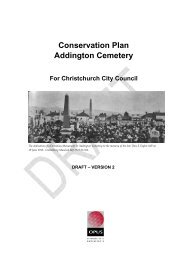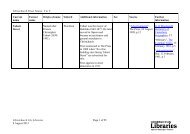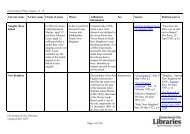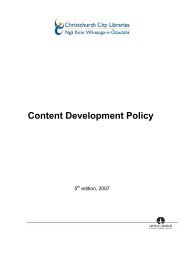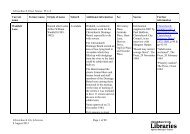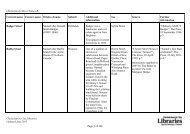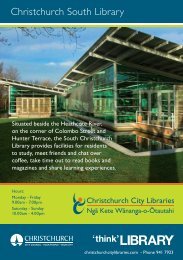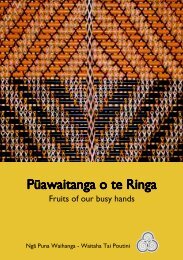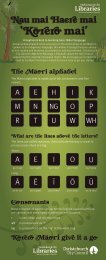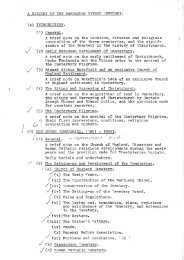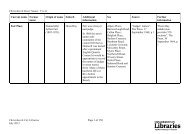Linwood Cemetery Tour Guide - Christchurch City Libraries
Linwood Cemetery Tour Guide - Christchurch City Libraries
Linwood Cemetery Tour Guide - Christchurch City Libraries
You also want an ePaper? Increase the reach of your titles
YUMPU automatically turns print PDFs into web optimized ePapers that Google loves.
undivided attention to the comfort and well-being of the pupils, and, if the<br />
applications warrant it, a commodious house will be erected immediately.<br />
Thereafter followed a comprehensive ‘Scheme of instruction’ divided into first and<br />
second classes, the former including English grammar and composition, ancient and<br />
modern history, geography, writing (plain and ornamental), arithmetic and<br />
mensuration, Scripture History and Biblical antiquities, and the elements of the<br />
natural sciences. Subjects in the second class were simpler, including the rudiments of<br />
English grammar and composition, English and colonial history, writing, arithmetic,<br />
Scripture history, geography and the elements of the natural sciences. The boys could,<br />
if it was desired, be taught elementary drawing and the rudiments of Latin … and<br />
algebra. The girls could be instructed in plain needlework.<br />
Knowles’ advertisements were effective. He moved into a 14 room boarding house<br />
built and owned by Ebenezer Hay who was pleased with the progress that his children<br />
made. Indeed, the school ‘soon acquired a truly excellent reputation throughout<br />
Canterbury’.<br />
On 30 August 1855, at Pigeon Bay’s ‘temporary church/schoolroom’ a Methodist<br />
minister, John Aldred, officiated at Knowles’ marriage to Charlotte Wiles.<br />
In 1856 Henry John Chitty Harper arrived to become the first Bishop of<br />
<strong>Christchurch</strong>. George Augustus Selwyn, Bishop of New Zealand, was waiting and,<br />
when the high clerics met, they baptised Walter Frank, infant son of Francis and<br />
Charlotte Knowles. Harper saw the promise that was in Francis and, on 20<br />
December 1857, the young man was made deacon at the first ordination carried out by<br />
the Bishop.<br />
For a time Knowles stayed at his school. However, he made it clear that he could not<br />
in the future, as he had in the past, make compromises with regard to religious<br />
instruction in school. Ebenezer Hay, a devout Presbyterian, obtained his agreement to<br />
leave the academy as soon as a new teacher could be found.<br />
The Church news was to describe Knowles’ work on Banks Peninsula. It commented<br />
that Canterbury<br />
… was intended to be a Church of England settlement; but much of the world<br />
entered into the scheme of things from the start; more of the world than the<br />
church seemed to shew forth in the results. Many of the first clergy were not<br />
equal to the task. The church hardly knew how to make good its claims. Then<br />
it was that young men offered themselves as helpers. Francis Knowles …<br />
went to Banks Peninsula as schoolmaster-catechist. Bishop Selwyn, sailing in<br />
his yacht amidst the mists that often hid the landmarks and prevented him<br />
from being certain as to which bay he was entering, found Francis Knowles<br />
doing his humble work faithfully among the few people in the district,<br />
teaching the children and riding about the hills after his scattered people. The<br />
young man did a deacon’s work and made good some of the deficiencies of<br />
the higher clergy. It was later stated that, on Banks Peninsula Knowles did<br />
most valuable work … and made up for some of the deficiencies of the higher<br />
clergy’.<br />
<strong>Linwood</strong> <strong>Cemetery</strong> <strong>Tour</strong> <strong>Guide</strong><br />
Updated 2013<br />
38


